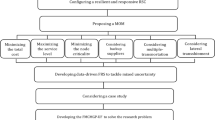Abstract
In this study, an interactive multi-stage stochastic fuzzy programming (IMSFP) approach has been developed through incorporating an interactive fuzzy resolution (IFR) method within an inexact multi-stage stochastic programming framework. IMSFP can deal with dual uncertainties expressed as fuzzy boundary intervals that exist in the objective function and the left- and right-hand sides of constraints. Moreover, IMSFP is capable of reflecting dynamics of uncertainties and the related decision processes through constructing a set of representative scenarios within a multi-stage context. A management problem in terms of water resources allocation has been studied to illustrate applicability of the proposed approach. The results indicate that a set of solutions under different feasibility degrees (i.e., risk of constraint violation) has been generated for planning the water resources allocation. They can not only help quantify the relationship between the objective-function value and the risk of violating the constraints, but also enable decision makers (DMs) to identify, in an interactive way, a desired compromise between two factors in conflict: satisfaction degree of the goal and feasibility degree of constraints. Besides, a number of decision alternatives have been generated under different policies for water resources management, which permits in-depth analyses of various policy scenarios that are associated with different levels of economic penalties when the promised water-allocation targets are violated, and thus help DMs to identify desired water-allocation schemes under uncertainty.








Similar content being viewed by others
References
Bellman RE, Zadeh LA (1970) Decision-making in a fuzzy environment. Manag Sci 17(4):141–164
Fang SC, Hu CF, Wang HF, Wu SY (1999) Linear programming with fuzzy coefficients in constraints. Computers & Mathematics with Applications 37(10):63–76
Heilpern S (1992) The expected valued of a fuzzy number. Fuzzy Set Syst 47(1):81–86
Huang GH (1998) A hybrid inexact-stochastic water management model. Eur J Oper Res 107(1):137–158
Huang GH, Chang NB (2003) The perspectives of environmental informatics and systems analysis. Journal of Environmental Informatics 1(1):1–7
Huang GH, Loucks DP (2000) An inexact two-stage stochastic programming model for water resources management under uncertainty. Civ Eng Environ Syst 17(2):95–118
Huang GH, Baetz BW, Patry GG (1992) A grey linear programming approach for municipal solid waste management planning under uncertainty. Civ Eng Environ Syst 9(4):319–335
Jairaj PG, Vedula S (2000) Multireservoir system optimization using fuzzy mathematical programming. Water Resources Management 14(6):457–472
Jiménez M, Arenas M, Bilbao A, Rodriguez MV (2007) Linear programming with fuzzy parameters: An interactive method resolution. Eur J Oper Res 177(3):1599–1609
Li YP, Huang GH, Nie SL (2006) An interval-parameter multi-stage stochastic programming model for water resources management under uncertainty. Advances in Water Resources 29(5):776–789
Li YP, Huang GH, Nie SL, Qin XS (2007) ITCLP: an inexact two-stage chance-constrained program for planning waste management systems. Resour Conserv Recycl 49(3):284–307
Li YP, Huang GH, Nie SL, Liu L (2008) Inexact multistage stochastic integer programming for water resources management under uncertainty. J Environ Manage 88(1):93–107
Li YP, Huang GH, Huang YF, Zhou HD (2009a) A multistage fuzzy-stochastic programming model for supporting sustainable water-resources allocation and management. Environ Model Softw 24(7):786–797
Li YP, Huang GH, Nie SL (2009b) Water resources management and planning under uncertainty: an inexact multistage joint-probabilistic programming method. Water Resources Management 23(12):2515–2538
Lu HW, Huang GH, He L (2010) Development of an interval-valued fuzzy linear-programming method based on infinite α-cuts for water resources management. Environ Model Softw 25(3):354–361
Luo B, Maqsood I, Yin YY, Huang GH, Cohen SJ (2003) Adaption to climate change through water trading under uncertainty – an inexact two-stage nonlinear programming approach. Journal of Environmental Informatics 2(2):58–68
Maqsood I, Huang GH, Yeomans JS (2005) An interval-parameter fuzzy two-stage stochastic program for water resources management under uncertainty. Eur J Oper Res 167(1):208–225
Nie XH, Huang GH, Li YP, Liu L (2007) IFRP: a hybrid interval-parameter fuzzy robust programming approach for waste management planning under uncertainty. J Environ Manage 84(1):1–11
Pereira MVF, Pinto LMVG (1991) Multi-stage stochastic optimization applied to energy planning. Math Program 52(1–3):359–375
Seifi A, Hipel KW (2001) Interior-point method for reservoir operation with stochastic inflows. ASCE-Journal of Water Resources Planning and Management 127(1):48–57
Slowinski R (1986) A multicriteria fuzzy linear programming method for water supply system development planning. Fuzzy Set Syst 19(3):217–237
Wang S, Huang GH (2011) Interactive two-stage stochastic fuzzy programming for water resources management. J Environ Manage 92(8):1986–1995
Wang LZ, Fang L, Hipel KW (2003) Water resources allocation: a cooperative game theoretic approach. Journal of Environmental Informatics 2(2):11–22
Watkins DW Jr, McKinney DC, Lasdon LS, Nielsen SS, Martin QW (2000) A scenario-based stochastic programming model for water supplies from the highland lakes. Int Trans Oper Res 7(3):211–230
Wu SM, Huang GH, Guo HC (1997) An interactive inexact-fuzzy approach for multiobjective planning of water resource systems. Water Sci Technol 36(5):235–242
Yager RR (1979) Ranking fuzzy subsets over the unit interval. In: Proceedings of 17th IEEE International Conference on Decision and Control, San Diego, CA, pp 1435–1437
Zadeh LA (1965) Fuzzy sets. Inf Control 8(3):338–353
Zadeh LA (1975) The concept of a linguistic variable and its applications to approximate reasoning. Part I Information Sciences 8: 199–249; Part II Information Sciences 8: 301–357; Part III. Inform Sci 9:43–80
Zadeh LA (1978) Fuzzy sets as a basis for a theory of possibility. Fuzzy Set Syst 1(1):3–28
Acknowledgements
The research was supported by the Major State Basic Research Development Program of MOST (2005CB724200 and 2006CB403307), and the Natural Science and Engineering Research Council of Canada. The authors would like to express thanks to the editor and the anonymous reviewers for their constructive comments and suggestions.
Author information
Authors and Affiliations
Corresponding author
Rights and permissions
About this article
Cite this article
Wang, S., Huang, G.H. Identifying Optimal Water Resources Allocation Strategies through an Interactive Multi-Stage Stochastic Fuzzy Programming Approach. Water Resour Manage 26, 2015–2038 (2012). https://doi.org/10.1007/s11269-012-9996-1
Received:
Accepted:
Published:
Issue Date:
DOI: https://doi.org/10.1007/s11269-012-9996-1




